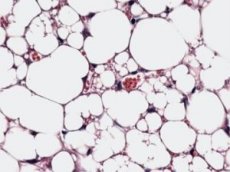Beige fat cells will help in the fight against obesity
Last reviewed: 23.04.2024

All iLive content is medically reviewed or fact checked to ensure as much factual accuracy as possible.
We have strict sourcing guidelines and only link to reputable media sites, academic research institutions and, whenever possible, medically peer reviewed studies. Note that the numbers in parentheses ([1], [2], etc.) are clickable links to these studies.
If you feel that any of our content is inaccurate, out-of-date, or otherwise questionable, please select it and press Ctrl + Enter.

Scientists of the Dana-Farber Cancer Institute (Dana-Farber Cancer Institute) have identified a new type of energy-burning fat cells developing in the depot of white fat of an adult. In their opinion, these cells can become the basis for new effective methods of treating obesity.
In an adult, these "beige" fat cells are located near the collarbone and along the spine in the size of a pea scattered under the skin of the depot. According to the study leader Bruce Spiegelman, PhD, and his colleagues, since this type of fat burns calories - and does not store them, as white-fat cells do - it can help in developing new methods for treating obesity and diabetes mellitus.
Dr. Spiegelman is the main author of the article published in the journal Cell.
The study showed that beige fat is genetically different from "brown fat," which also burns calories for heat production. Brown fat is found in young mammals and babies, which it protects from hypothermia. In contrast to brown fat, white fat stores calories, and its excess contributes to the development of obesity.
The possibility of the existence of this third type of fat (in addition to white and brown) was predicted by Dr. Spiegelman in 2008, but the group from the Dana-Farber Cancer Institute first isolated these cells and determined their unique genetic profile. In a new article, Dr. Spiegelman and his colleagues reported that beige fat cells are a specific target of the hormone irisin (irisin), expressed by muscle cells under physical exertion.

In 2009, three research groups immediately reported the discovery of brown fat stores in the adult body, but Spigelman's latest work, based on the genetic profile of the cells, identifies them as beige fat.
Even in small quantities, brown and beige fat can burn large amounts of calories.
Brown fat produces heat with the help of mitochondrial uncoupling protein UCP1, protecting the body from hypothermia and obesity. Recent evidence suggests that there are two different types of brown fat: classical brown fat, derived from the myf-5 cell line, and UCP1-positive cells that are formed in white fat from the non-myf-5 line. Scientists of the Oncological Institute Dana-Farbera isolated beige cells from the depots of white fat mice. Beige fat cells resemble white fat cells in that they have extremely low basic expression of UCP1, but like the classic brown fat, they react to cyclic AMP stimulation by high expression of UCP1 and respiratory rate. The pattern of gene expression of beige cells is different from that of both white and brown fat, and these cells are predominantly sensitive to the polypeptide hormone irisin. The researchers provided convincing evidence that the previously identified depots of brown fat in the adult body consist of beige adipocytes.
"The therapeutic potential of both these types of fat cells is clear," the authors write in an article in Cell, "because genetic manipulation of mouse cells, leading to more brown or beige fat, can successfully combat obesity and diabetes."
Scientists are already looking for ways to use brown fat for the benefit of man.
Cells of both brown and beige fat contain energy-burning organelles of mitochondria, which contain iron, which determines the brown and beige shades of these tissues. The main difference is that brown fat cells express high levels of UCP1 - the protein needed for mitochondria to burn calories and produce heat - while under normal conditions the basal level of expression of this protein in beige cells is low. However, beige cells can enhance the synthesis of UCP1 in response to cold or certain hormones such as irisin, which allows beige fat to burn calories almost as effectively as brown.
Dr. Spiegelman made a number of discoveries about the different types of fat cells. He found that brown fat cells originate from stem progenitor cells, of which muscle cells also develop. Cells of beige fat are formed in white fat from the precursors of beige cells.
Earlier this year, Spiegelman reported the discovery of the hormone irisin, produced by muscle cells during exercise and transforming white fat into brown. In a new article in Cell, Spiegelman reports that irisin specifically stimulates the production of beige by white fat. The Dana-Farber Cancer Institute has licensed both discoveries of the biotechnology company Ember Therapeutics, founded by Spiegelman, which plans to receive a drug for treating obesity and diabetes based on irisin.


 [
[